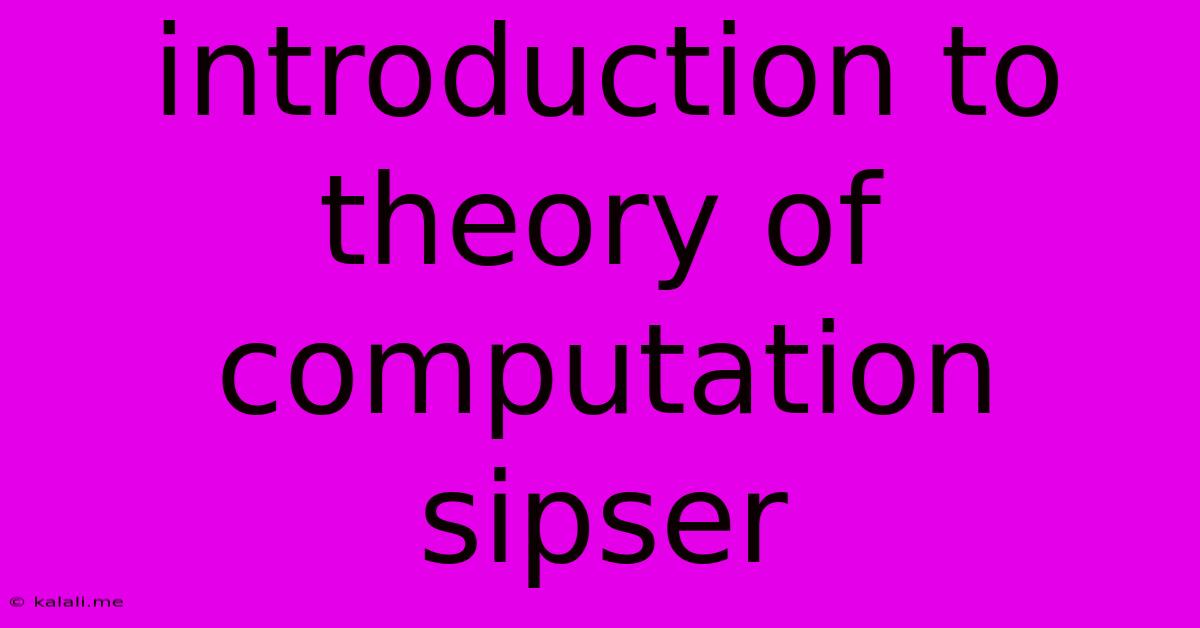Introduction To Theory Of Computation Sipser
Kalali
Jun 02, 2025 · 3 min read

Table of Contents
Introduction to the Theory of Computation: A Deep Dive into Sipser's Classic Text
Meta Description: This article provides a comprehensive introduction to Sipser's "Introduction to the Theory of Computation," covering its key topics, approach, and why it's considered a seminal text in the field. We'll explore the book's structure, its strengths, and how it helps students understand the fundamental concepts of computation.
The Theory of Computation is a fascinating field exploring the limits of what computers can and cannot compute. Michael Sipser's "Introduction to the Theory of Computation" is widely regarded as the gold standard textbook for this subject, and for good reason. This article serves as an introduction to the book, outlining its key features and why it’s crucial for anyone studying computer science or related disciplines.
What is the Theory of Computation?
Before delving into Sipser's book, let's briefly understand the field itself. The Theory of Computation fundamentally deals with:
- Automata Theory: Studying abstract computing machines (like Finite Automata, Pushdown Automata, and Turing Machines) and their computational power.
- Computability Theory: Investigating what problems are solvable by computers (decidable problems) and those that are not (undecidable problems).
- Complexity Theory: Analyzing the resources (time and space) required to solve computational problems, leading to classifications like P, NP, and NP-complete problems.
Sipser's Approach: Clarity and Rigor
Sipser's book excels in its balance of rigor and accessibility. While it doesn't shy away from formal definitions and proofs, it presents the material in a clear and engaging manner. The author masterfully uses intuitive explanations and examples to illuminate even the most complex concepts, making it suitable for both undergraduate and graduate students.
Key Topics Covered in Sipser's Book:
Sipser's "Introduction to the Theory of Computation" systematically covers the core areas of the field:
- Finite Automata and Regular Languages: This introduces fundamental computational models and their limitations, building a strong foundation for subsequent topics. Key concepts include regular expressions, deterministic and nondeterministic finite automata, and closure properties of regular languages.
- Context-Free Grammars and Pushdown Automata: This section explores more powerful computational models capable of handling context-free languages, crucial for understanding programming language parsing and compiler design.
- Turing Machines and Computability: This introduces the Turing machine, a powerful theoretical model of computation that forms the basis for understanding computability and undecidability. The book meticulously explores concepts like Church-Turing Thesis and the Halting Problem.
- Decidability and Undecidability: This delves into the limits of computation, exploring problems that are solvable and those that are fundamentally unsolvable by any algorithm.
- Computational Complexity: The book introduces the concepts of time and space complexity, P vs. NP, NP-completeness, and reduction techniques, crucial for understanding the practical limitations of solving computationally hard problems.
Why Sipser's Book is a Must-Read:
- Comprehensive Coverage: It covers all the essential topics in the Theory of Computation in a well-structured and logical sequence.
- Clear and Concise Writing Style: Sipser's writing style is renowned for its clarity, making complex concepts easier to grasp.
- Abundant Examples and Exercises: The book includes numerous examples and exercises to reinforce understanding and promote active learning.
- Rigorous Treatment: While accessible, it maintains a high level of mathematical rigor, providing a solid foundation for further study.
- Widely Adopted and Respected: Its widespread adoption in universities worldwide attests to its quality and effectiveness.
Conclusion: A Foundational Text for Computer Scientists
Sipser's "Introduction to the Theory of Computation" is more than just a textbook; it's a gateway to understanding the fundamental principles governing computation. Its clarity, rigor, and comprehensive coverage make it an invaluable resource for anyone venturing into the fascinating world of theoretical computer science. Whether you're a student, researcher, or simply curious about the limits of computation, this book is a must-read. By mastering the concepts within, you'll gain a deeper appreciation for the power and limitations of computing, crucial knowledge for any serious computer scientist.
Latest Posts
Latest Posts
-
Can You Take Protein Powder On The Plane
Jun 04, 2025
-
Do I Need An Alignment After Replacing Upper Control Arm
Jun 04, 2025
-
Lyrics 25 Or 6 To 4 Meaning
Jun 04, 2025
-
Borderless Fullscreen Doesnt Work For Dishonored 2
Jun 04, 2025
-
Saying Liar Liar Pants On Fire
Jun 04, 2025
Related Post
Thank you for visiting our website which covers about Introduction To Theory Of Computation Sipser . We hope the information provided has been useful to you. Feel free to contact us if you have any questions or need further assistance. See you next time and don't miss to bookmark.